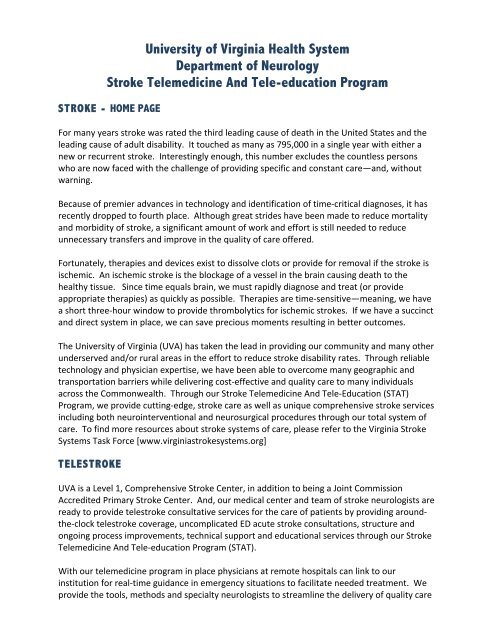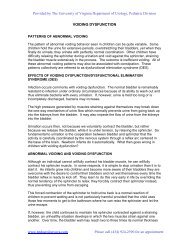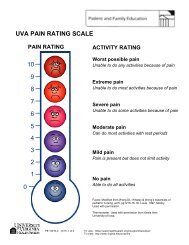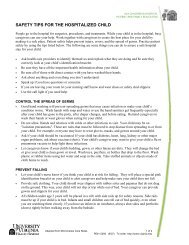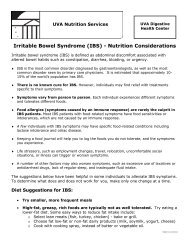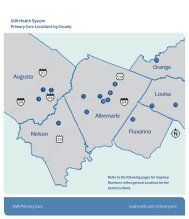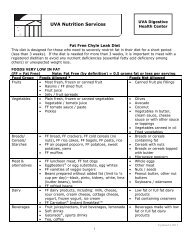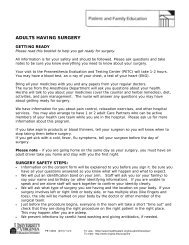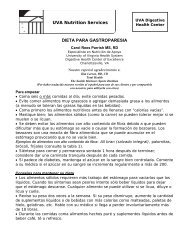STAT WEBSITE University of Virginia Health System
STAT WEBSITE University of Virginia Health System
STAT WEBSITE University of Virginia Health System
Create successful ePaper yourself
Turn your PDF publications into a flip-book with our unique Google optimized e-Paper software.
<strong>University</strong> <strong>of</strong> <strong>Virginia</strong> <strong>Health</strong> <strong>System</strong><br />
Department <strong>of</strong> Neurology<br />
Stroke Telemedicine And Tele-education Program<br />
STROKE - HOME PAGE<br />
For many years stroke was rated the third leading cause <strong>of</strong> death in the United States and the<br />
leading cause <strong>of</strong> adult disability. It touched as many as 795,000 in a single year with either a<br />
new or recurrent stroke. Interestingly enough, this number excludes the countless persons<br />
who are now faced with the challenge <strong>of</strong> providing specific and constant care—and, without<br />
warning.<br />
Because <strong>of</strong> premier advances in technology and identification <strong>of</strong> time-‐critical diagnoses, it has<br />
recently dropped to fourth place. Although great strides have been made to reduce mortality<br />
and morbidity <strong>of</strong> stroke, a significant amount <strong>of</strong> work and effort is still needed to reduce<br />
unnecessary transfers and improve in the quality <strong>of</strong> care <strong>of</strong>fered.<br />
Fortunately, therapies and devices exist to dissolve clots or provide for removal if the stroke is<br />
ischemic. An ischemic stroke is the blockage <strong>of</strong> a vessel in the brain causing death to the<br />
healthy tissue. Since time equals brain, we must rapidly diagnose and treat (or provide<br />
appropriate therapies) as quickly as possible. Therapies are time-‐sensitive—meaning, we have<br />
a short three-‐hour window to provide thrombolytics for ischemic strokes. If we have a succinct<br />
and direct system in place, we can save precious moments resulting in better outcomes.<br />
The <strong>University</strong> <strong>of</strong> <strong>Virginia</strong> (UVA) has taken the lead in providing our community and many other<br />
underserved and/or rural areas in the effort to reduce stroke disability rates. Through reliable<br />
technology and physician expertise, we have been able to overcome many geographic and<br />
transportation barriers while delivering cost-‐effective and quality care to many individuals<br />
across the Commonwealth. Through our Stroke Telemedicine And Tele-‐Education (<strong>STAT</strong>)<br />
Program, we provide cutting-‐edge, stroke care as well as unique comprehensive stroke services<br />
including both neurointerventional and neurosurgical procedures through our total system <strong>of</strong><br />
care. To find more resources about stroke systems <strong>of</strong> care, please refer to the <strong>Virginia</strong> Stroke<br />
<strong>System</strong>s Task Force [www.virginiastrokesystems.org]<br />
TELESTROKE<br />
UVA is a Level 1, Comprehensive Stroke Center, in addition to being a Joint Commission<br />
Accredited Primary Stroke Center. And, our medical center and team <strong>of</strong> stroke neurologists are<br />
ready to provide telestroke consultative services for the care <strong>of</strong> patients by providing around-‐<br />
the-‐clock telestroke coverage, uncomplicated ED acute stroke consultations, structure and<br />
ongoing process improvements, technical support and educational services through our Stroke<br />
Telemedicine And Tele-‐education Program (<strong>STAT</strong>).<br />
With our telemedicine program in place physicians at remote hospitals can link to our<br />
institution for real-‐time guidance in emergency situations to facilitate needed treatment. We<br />
provide the tools, methods and specialty neurologists to streamline the delivery <strong>of</strong> quality care
in a moment’s notice. These services and improvements can improve the average door-‐to-‐<br />
needle time for thrombolytic treatment, average length <strong>of</strong> hospital stay, long-‐term disability<br />
and overall cost per case. Our mission is to share the responsibility with regional hospitals for<br />
building quality acute stroke programs in the Commonwealth.<br />
We believe in: 1). Using technology to deliver quality stroke treatments in the closest location<br />
to the patient, 2). Spreading knowledge and first-‐hand experience to accelerate door-‐to<br />
treatment time, and 3). Help more patients; strive to provide services and support at the<br />
lowest possible cost.<br />
“Strokes don’t ask questions or make exceptions for anyone. Being prepared for<br />
the worst has prepared us for being the best when it comes to striking back at<br />
stroke. By working together and using a stroke delivery system, we exhibit a<br />
STROKE OF GENIUS.”<br />
Andrea C. Lomboy<br />
<strong>STAT</strong> Program Coordinator<br />
STROKE TELE-MEDICINE AND TELE-EDUCATION (<strong>STAT</strong>)<br />
The mission <strong>of</strong> the Stroke Telemedicine And Tele-‐education (<strong>STAT</strong>) Program is to provide<br />
advanced specialty care resulting in the best and timely treatment for acute stroke patients<br />
received by our skilled team <strong>of</strong> stroke neurologists from referring hospitals. By collaborating<br />
with regional hospitals, we can build quality stroke systems <strong>of</strong> care, reducing the burden <strong>of</strong><br />
stroke in the Commonwealth <strong>of</strong> <strong>Virginia</strong>. Our goal is to use every resource available to enhance<br />
the quality <strong>of</strong> life pre and post stroke with comprehensive and compassionate care. In addition,<br />
we provide support to local medical pr<strong>of</strong>essionals through our telestroke and educational<br />
services.<br />
“The <strong>STAT</strong> Program allows 24-‐hour acute stroke expertise-‐on-‐demand, as well as<br />
the added expertise <strong>of</strong> our entire team <strong>of</strong> stroke care specialists, from emergency<br />
department staff to the neurocritical nurses.” “We <strong>of</strong>fer a 100% acceptance policy<br />
for all acute stroke transfers – maximizing the patient recovery by delivering a<br />
timely assessment, diagnosis and determination <strong>of</strong> eligibility for short-‐term<br />
therapy and treatment. “<br />
Nina Solenski, M.D.<br />
Director, <strong>STAT</strong> Program<br />
<strong>University</strong> <strong>of</strong> <strong>Virginia</strong><br />
The UVA <strong>Health</strong> <strong>System</strong> is able to break through many <strong>of</strong> the barriers that hinder access to<br />
specialty care and key medications for timely treatment. This system provides for constant (24<br />
hours a day, 7 days a week), yet flexible way to provide quality care that is monitored and<br />
improved through both the hub and spoke hospitals.<br />
2
The benefits include providing or improving access to care in neurologically underserved areas,<br />
and reducing medical costs (e.g., travel to UVA, equipment). The results can drastically reduce<br />
stroke mortality and disability while improving quality <strong>of</strong> life for survivors and their families.<br />
When our <strong>STAT</strong> system is activated, everyone – from our page operators and radiology staff, to<br />
our highly trained nursing and medical staff – are sequentially alerted and begin emergent<br />
preparations to treat our patients with the highest level <strong>of</strong> care available. Quality is our<br />
primary goal. To achieve this we provide on-‐site partnership training, and <strong>of</strong>fer online training,<br />
to assist in the development <strong>of</strong> community healthcare events. We are committed to constant<br />
improvement, and we conduct 24-‐hour feedback and quarterly feedback for quality initiatives.<br />
We also meet quarterly with the local Emergency Department and staff to provide a six-‐month<br />
review <strong>of</strong> all <strong>of</strong> the presenting cases to close the loop on each patient.<br />
The following graphic is a snapshot <strong>of</strong> our system-‐to-‐system overview representing a hub (UVA<br />
HS) and spoke (initiating or referring hospital) configuration.<br />
THE SYSTEM<br />
The goal <strong>of</strong> this flexible <strong>STAT</strong> program is to provide an efficient and methodical approach for<br />
quickly recognizing an acute ischemic stroke and treating it as quickly as possible with the most<br />
appropriate treatment available in your institution and in ours. Our system includes the<br />
following conduits that lead to a successful program:<br />
• Physician to Physician (Consultation)<br />
• PACs (Radiology & Image Transfers)<br />
• EMS (Patient Transfer)<br />
• Telemedicine (Policy, Procedures, Manuals, How To’s, Training, Video Conferencing)<br />
3
Each component can be customized for maximum performance thereby improving overall<br />
quality <strong>of</strong> life outcomes. Every element <strong>of</strong> the system is necessary to make the process<br />
seamless increasing survival and minimizing disability.<br />
Evaluation and Treatment in 60 Minutes or Less:<br />
• Door to MD ≤ 10 minutes: Patient complaint, vital signs, ECG<br />
• ED Physician ≤ 15 minutes: Focused history and physical exam, laboratories, stroke team<br />
activation, transport for CT Scan (stroke protocol) vital sign monitoring, neurologic<br />
checks, seizure and aspiration precautions<br />
• CT Scan and Stroke Neurology Consult ≤ 20 minutes: Review history, physical exam, CT<br />
Scan interpretation<br />
• Treatment Decision and Initiate IV rt-‐PA infusion ≤15 minutes: per guideline based<br />
protocol<br />
Naturally, the first component <strong>of</strong> our system is a complimentary, customizable and quick<br />
quality improvement program that is simple to implement. Upon implementation <strong>of</strong> the <strong>STAT</strong><br />
PAC Program, you will be given a supply <strong>of</strong> <strong>STAT</strong> PAC materials that are “ready to go.” The<br />
contents <strong>of</strong> the packet will assist your team through the process systematically and the<br />
documentation will lend itself to quality improvement—measuring areas <strong>of</strong> effectiveness and<br />
efficiency—leading to even more successful outcomes! This packet will be opened for every<br />
acute stroke and direct precise documentation <strong>of</strong> every key step in the appropriate care and<br />
treatment. This is the initiation <strong>of</strong> the first conduit (Physician to Physician). The ED Physician<br />
“the personal provider contact” at the hub hospital will open the packet, begin treatment and<br />
initiate contact with the Acute Stroke Team Leader at the UVA <strong>Health</strong> <strong>System</strong>.<br />
Critical tests are then obtained and discussed in consultation (via video teleconferencing or<br />
telephone (PACs -‐ Radiology & Image Transfers). Once contact has been established,<br />
consultation will begin as images are exchanged and treatment ensues (Telemedicine -‐ Policy,<br />
Procedures, Manuals, How To’s, Training, Video Conferencing). Once a plan <strong>of</strong> care has been<br />
determined, the patient either remains at the referring hospital for extended care, or<br />
transferred to the UVA <strong>Health</strong> <strong>System</strong> for supplemental care (EMS – Patient Transfer).<br />
However, the system doesn’t stop there. The documentation that was filled out at the referring<br />
hospital is sent with the patient to the receiving hospital. The case is reviewed and key data is<br />
extracted and presented for quality improvement (Case Specific Feedback – and overall process<br />
review) with our Acute Stroke Quality Improvement Team.<br />
If the patient somehow falls outside <strong>of</strong> the window <strong>of</strong> opportunity for thrombolytic treatment,<br />
there are other options, including interventional radiology (mechanical clot retrieval devices<br />
and others) or neurosurgical procedures that can be <strong>of</strong>fered at our comprehensive stroke<br />
center. With your partnership, we are able to use combined best practices, therefore, raising<br />
the level <strong>of</strong> acute stroke care and treatment all across <strong>Virginia</strong>.<br />
"We <strong>of</strong>fer a 100% acceptance policy for all acute stroke transfers – maximizing the<br />
patient recovery by delivering a timely assessment, diagnosis and determination<br />
4
<strong>of</strong> eligibility for short term therapy and treatment. This system works for any<br />
location because it is complimentary, completely customizable and critical for<br />
achieving comprehensive care and quality outcomes.”<br />
David Burt, M.D.<br />
<strong>STAT</strong> Emergency Medicine & <strong>System</strong>s Consultant and<br />
Assistant Pr<strong>of</strong>essor, Emergency Medicine<br />
<strong>University</strong> <strong>of</strong> <strong>Virginia</strong><br />
We invite you to learn more about telestroke. We are not only interested in helping your<br />
organization, but advancing the overall system <strong>of</strong> care across <strong>Virginia</strong> (and beyond state lines).<br />
We have provided a Frequently Asked Questions (FAQs) to summarize key points that may be<br />
<strong>of</strong> interest to you. We look forward to hearing from your organization.<br />
IMPLEMENTATION<br />
Our program can easily be implemented with our Office <strong>of</strong> Telemedicine. The timeline for<br />
implementation depends on whether the site has existing equipment experience and sufficient<br />
connectivity. The technology cost (equipment) can range from a modest $10k -‐ $18k depending<br />
on the sophistication and specifications <strong>of</strong> the system.<br />
Cost savings are accumulated when considering the<br />
possibility <strong>of</strong> decreasing unnecessary patient<br />
transfers and/or retaining patients at the local<br />
hospital for care (or returned to local<br />
rehabilitation). Once a system has been set into<br />
place, it is very easy to extend our services to<br />
include remote inpatient stroke consultations.<br />
"With good planning and vision, our<br />
telestroke program can be operational<br />
quickly and in an affordable manner-‐<br />
increasing the capability <strong>of</strong> the local hospital<br />
with teleconsultation.”<br />
David Cattell-‐Gordon<br />
Director, Office <strong>of</strong> Telemedicine<br />
<strong>University</strong> <strong>of</strong> <strong>Virginia</strong><br />
OUR TEAM<br />
INITIAL TECHNICAL CONSIDERATIONS<br />
Site Requirements<br />
• Dedicated Emergency Room with a<br />
landline telephone connection and<br />
internet access<br />
• 24-‐hour laboratory testing<br />
• Pharmacy access for TPA<br />
Equipment & Technology<br />
• Video Conferencing equipment, H323<br />
Compatibility<br />
• 24 hour CT scanner<br />
• T1 connection with a minimum<br />
available bandwidth <strong>of</strong> 900 Kbps<br />
• PC with internet<br />
• Teleradiology capability (PACs)<br />
Our team <strong>of</strong> double-‐boarded stroke neurologists is dedicated to providing specialty telestroke<br />
consultative services for acute stroke care. Our overall goal is to increase quality <strong>of</strong> life pre-‐ and<br />
post-‐stroke. We provide 24/7 telestroke consultative services for those who are connected to<br />
our system.<br />
5
Our supporting team provides advanced capabilities at our comprehensive Stroke Center and<br />
includes:<br />
• Dr. Nina Solenski, Associate Pr<strong>of</strong>essor <strong>of</strong> Neurology—the Director <strong>of</strong> the <strong>STAT</strong> Program,<br />
Board-‐certified Vascular Neurology, General Neurology<br />
• Andrea Lomboy, <strong>STAT</strong> Program Coordinator<br />
• Amy Halpin, <strong>STAT</strong> Data Analyst<br />
• Dr. David Burt, Associate Pr<strong>of</strong>essor, Emergency Department<br />
• Dr. Lee Jensen, Director <strong>of</strong> Interventional Radiology/Pr<strong>of</strong>essor <strong>of</strong> Radiology and<br />
Neurosurgery<br />
• David Cattell-‐Gordon, Director <strong>of</strong> the Office <strong>of</strong> Telemedicine<br />
When our <strong>STAT</strong> system is activated, everyone – from our page operators and radiology staff, to<br />
our highly trained nursing and medical staff – are sequentially alerted and begin emergent<br />
preparations to treat our patients with the highest level <strong>of</strong> care available. To complement our<br />
medical staff, we employ three additional interventional neuroradiologists along with two<br />
neurovascular surgeons (on cases requiring endovascular treatment, or emergency<br />
neurosurgical care). We are devoted to enhancing the quality and duration <strong>of</strong> life for all who<br />
have been faced with the devastating effects <strong>of</strong> stroke. Even if we miss the narrow three hour<br />
window <strong>of</strong> opportunity to treat an acute ischemic stroke with tPA, our team expands the<br />
possibilities <strong>of</strong> additional life saving and enabling treatment.<br />
We strongly believe in sharing the burden <strong>of</strong> responsibility for stroke. We have participated in<br />
raising the bar across the Commonwealth as participants in the <strong>Virginia</strong> Acute Stroke Telehealth<br />
Network (VAST). Our contributions in the initial design, development, testing and evaluation <strong>of</strong><br />
a model stroke network has set the stage for small rural hospitals—lending stroke expertise in<br />
regions <strong>of</strong> <strong>Virginia</strong> that might have not otherwise received such specialty care.<br />
OUR FACILITY<br />
The UVA <strong>Health</strong> <strong>System</strong> is a tertiary care institution with 13 dedicated stroke beds and 16<br />
dedicated neurosciences ICU beds. And, is ever growing to meet the needs <strong>of</strong> our community<br />
throughout the state. It is ranked among the nation’s top 20 centers by U.S. News & World<br />
Report in research and treatment for disorders affecting the nervous system. As a Level 1<br />
Comprehensive Stroke Center, we are nationally certified by the Joint Commission [link to<br />
http://www.jointcommission.org] as a Primary Stroke Center and are recognized for the<br />
exceptional quality <strong>of</strong> services we <strong>of</strong>fer to achieve better outcomes and long-‐term success rates<br />
for our stroke patients.<br />
Stroke patients transferred or admitted to the UVA <strong>Health</strong> <strong>System</strong> will be cared for in the<br />
Nerancy Neuro Intensive Care Unit (NNICU) to receive state-‐<strong>of</strong>-‐the-‐art care. The NNICU<br />
provides skilled intense observation and monitoring <strong>of</strong> patients following a stroke, through<br />
compassionate and highly skilled neuro-‐trained nursing care staff.<br />
Post-‐stroke, patients may be seen in one <strong>of</strong> our two clinics: UVA Comprehensive Stroke Clinic<br />
or the Neurovascular-‐Neurosurgery Clinic. Patients are frequently evaluated by a team <strong>of</strong><br />
physicians, a stroke neurologist, vascular neurosurgeon, and neuroradiologists. For patients<br />
6
eceiving rehabilitation, UVA is affiliated with the accredited UVA-‐<strong>Health</strong>South Rehabilitation<br />
Hospital.<br />
TELE-EDUCATION<br />
Education is key to understanding and ascribing to good health and reasonable health practices.<br />
With the availability <strong>of</strong> distributed mobile distance learning, the opportunities to teach about<br />
stroke and the co-‐morbidities <strong>of</strong> stroke are at our fingertips are plentiful throughout the state<br />
[link to: http://www.healthsystem.virginia.edu/pub/<strong>of</strong>fice-‐<strong>of</strong>-‐telemedicine/map-‐<strong>of</strong>-‐facilities].<br />
We have expanded our Stroke Telemedicine And Tele-‐Education (<strong>STAT</strong>) Program to provide<br />
pr<strong>of</strong>essional stroke education vignettes and lectures that are housed online.<br />
We are currently collaborating with HEALTHeCongregations ® to educate communities <strong>of</strong><br />
faith about stroke. We hope to empower the local congregations (7,000+ in <strong>Virginia</strong>) through<br />
mobile distance learning prevention and awareness educational programs for both leaders and<br />
members. Our goal is to leverage the power <strong>of</strong> technology while uniting faith-‐based principles<br />
with health best practices to promote prevention to build healthier communities.<br />
“We must align the best practices <strong>of</strong> the health and faith communities, as they are<br />
intricately linked. Through synergistic programs, we can capture the interest <strong>of</strong> our<br />
communities and teach good health from the cradle to the grave—and, when health<br />
fails, be strengthened ultimately by faith. This collaborative approach is sorely needed,<br />
as stroke does not discriminate. Everyone can be at risk. “<br />
CONTACT US<br />
Rev. Andrea C. Lomboy<br />
Chair, Community Education Committee<br />
Member, <strong>Virginia</strong> Stroke <strong>System</strong>s Task Force<br />
Stroke Telemedicine And Tele-‐Education Program Coordinator<br />
<strong>University</strong> <strong>of</strong> <strong>Virginia</strong><br />
For more information about the Stroke Telemedicine And Tele-‐Education Program, feel free to<br />
contact the following:<br />
• Nina Solenski, MD, <strong>STAT</strong> Program Director & Associate Pr<strong>of</strong>essor <strong>of</strong> Neurology<br />
UVA Primary Stroke Center<br />
Box 800394, Hospital Drive<br />
Charlottesville, VA 22908<br />
Office: 434-‐924-‐2783<br />
Fax: (434)982-‐1726<br />
Email: njs2j@virginia.edu<br />
7
FAQs<br />
• Andrea Lomboy, <strong>STAT</strong> Program Coordinator & HEALTHeCongregations ® Program Manager<br />
<strong>University</strong> <strong>of</strong> <strong>Virginia</strong>, Primary Stroke Center, Department <strong>of</strong> Neurology<br />
Mail Box 800394, McKim Hall, Office 1057 Cobb Hall<br />
Hospital Drive, Charlottesville, VA 22908-‐0394<br />
Cell: 703/581-‐4323<br />
Fax: 888-‐221-‐1649<br />
Email: alomboy@virginia.edu<br />
• David R. Burt, <strong>STAT</strong> Emergency Medicine & <strong>System</strong>s Consultant and Assistant Pr<strong>of</strong>essor,<br />
Emergency Medicine<br />
<strong>University</strong> <strong>of</strong> <strong>Virginia</strong><br />
Department <strong>of</strong> Emergency Medicine<br />
PO Box 800699<br />
Charlottesville, VA 22908-‐0699<br />
Cell: 434-‐924-‐2428<br />
Email: drb5p@virginia.edu<br />
What is telemedicine and how does it relate to telestroke?<br />
Telemedicine is the use <strong>of</strong> electronic communication and information technologies to provide<br />
or support clinical care at a distance. Telestroke is further defined through the use <strong>of</strong><br />
telemedicine services with a specialty in acute stroke care and rehabilitation.<br />
What are the bottom line benefits from telestroke services?<br />
Thousands <strong>of</strong> patients in underserved areas may receive services that they may not have<br />
otherwise received without traveling great distances or overcoming personal or transportation<br />
barriers. We <strong>of</strong>fer our telestroke services at the lowest cost possible, with the highest quality<br />
<strong>of</strong> care available today. The cost savings are across the board—patient, spoke hospital and the<br />
hub hospital.<br />
Through telemedicine we are able to help you keep nearly 70% <strong>of</strong> all consults at your institution<br />
increasing spoke hospital revenues. Even if the patient is transferred, they typically return to<br />
the community for local rehabilitation.<br />
How much will a telestroke program cost?<br />
The costs for the implementation <strong>of</strong> a telestroke program varies with each spoke hospital.<br />
Costs include:<br />
o Equipment<br />
o Network/Connectivity (adequate bandwidth is necessary for quality operation)<br />
8
o Program Support Fee (contracted well in advance <strong>of</strong> implementation)<br />
In our experience, many hospitals already have some or most <strong>of</strong> the essentials in place<br />
already—it’s just a matter <strong>of</strong> us helping you fill in any missing pieces or gaps to make the<br />
system complete.<br />
For more information, please contact the Office <strong>of</strong> Telemedicine Director or the <strong>STAT</strong> Program<br />
Coordinator at the <strong>University</strong> <strong>of</strong> <strong>Virginia</strong> <strong>Health</strong> <strong>System</strong>. We can arrange a site visit for you and<br />
your staff.<br />
Are there any additional consultation costs that we should expect?<br />
No. Our program fees covers all on-‐call and consultation services. We make it simple and easy.<br />
How does telestroke billing work and what are the federal mandates associated with it?<br />
Clinical services provided through telehealth is reimbursable by Medicare and most third-‐party<br />
payers. Medicaid reimbursement policies vary by state. In <strong>Virginia</strong>, reimbursement for<br />
telehealth services is determined on a case-‐by-‐case basis. Technical fees to cover the network<br />
expenses are not included in the reimbursement structure.<br />
The <strong>University</strong> <strong>of</strong> <strong>Virginia</strong> <strong>Health</strong> <strong>System</strong> (UVA HS) will bill the patient or the patient’s insurance<br />
for the consultation fee only. The site hospital will bill for the interpretation <strong>of</strong> the CT. UVA HS<br />
will not bill for the CT interpretation or ‘over-‐read.’ In the event the patient is referred or<br />
admitted to for services other than those specified in our agreement, UVA HS will bill the<br />
patient, or the patient’s insurance carrier for only those services in accordance with its normal<br />
conduct <strong>of</strong> business. Our guidelines are based on the federal mandates that can be found<br />
published in the Federal Register / Vol. 76, No. 87 / Thursday, May 5, 2011 / Rules and<br />
Regulations, pages 25551 and following.<br />
Can you help us throughout the implementation process to become part <strong>of</strong> your successful<br />
and sustainable telestroke network?<br />
Absolutely! Within the past 17 years we have had the privilege to perform nearly 24,000<br />
consultations in over 30 specialties along side telestroke. We have a system in place that<br />
ensures success with the cooperation and coordination <strong>of</strong> your facility—at your pace, and at<br />
your request.<br />
Does telemedicine and the teleconsultation provide for adequate patient privacy and<br />
confidentiality?<br />
Yes. A telestroke consultation is HIPAA-‐compliant, and the spoke site personnel are responsible<br />
for obtaining a signed telemedicine consent and HIPAA policy from each patient. Our site<br />
utilizes a HIPAA-‐secure virtual private network to ensure secure transmission <strong>of</strong> all electronic<br />
patient health information.<br />
Are there liabilities associated with telestroke consultation?<br />
9
The liabilities are virtually the same as if the consultation were performed in person. There are<br />
no hidden or extra liabilities by using telemedicine or telestroke consultations.<br />
How can I be certain that the physicians at the hub hospital are qualified to perform<br />
telestroke services?<br />
Our <strong>STAT</strong> Program has been built from the ground up with the most experienced acute stroke<br />
neurological attendings employed by the UVA HS. Each have been adequately trained and<br />
experienced in every aspect <strong>of</strong> our system. We train not only our physicians, but also every<br />
individual from our page operators to our neurosurgeons about their role to contribute to the<br />
best possible outcome possible.<br />
How do you handle physician credentialing issues?<br />
The CMS and Joint Commission agree that physicians can only engage in telemedicine in states<br />
where they hold a pr<strong>of</strong>essional license. Secondly, for purposes <strong>of</strong> telemedicine between<br />
facilities UVA complies with all CMS rules regarding credentialing and privileging. Effective July<br />
2, 2011, the final rule revised sections <strong>of</strong> the CoP for hospitals and CAHs allow the governing<br />
body (or responsible individual for CAHs) to accept the “credentialing and privileging decisions<br />
made by the distant-‐site telemedicine entity” for individual physicians or non-‐physician<br />
practitioners asked to provide telemedicine services. In addition, the governing body must<br />
obtain a written agreement specifying the distant-‐site entity as a “contractor <strong>of</strong> services” and<br />
stating the distant-‐site entity ensures all furnished services will comply with applicable CoP<br />
criteria for hospitals or CAHs.<br />
What if the spoke ED physician does not agree with the telestroke consultant?<br />
The final decisions are always made by the bedside physician treating the patient. We<br />
understand your role and relationship with those who you serve in your community. We trust<br />
that you know what’s best for your patient. You are under no obligation to follow our<br />
recommendations as consulting physicians.<br />
Am I obligated to send all referrals to the UVA HS if they provide the initial telestroke<br />
consultation?<br />
No. Your decision to make a transfer or referral is solely your choice. We are happy to<br />
participate in the process. After all, our goal is to improve acute stroke across the<br />
Commonwealth—not just where we can have a pr<strong>of</strong>ound effect on mortality and morbidity.<br />
What if I no longer desire to use the <strong>STAT</strong> Program or make referrals to UVA HS?<br />
We hope that our 24/7 acute stroke care services and consultations will assist you in every way<br />
possible. You are under no obligation if you choose not to use our services. However, we are<br />
always available any time you need us—with a 100% bed acceptance guarantee every time.<br />
10
We are new to this telestroke concept. Will you “take” our stroke patients away from our<br />
facility and our community?<br />
No. Our mission statement says it best, “We hope to empower the local community hospital so<br />
that they can provide specialty treatment to patients so that they can remain in the community<br />
in which they reside.” Our goal is to confer with the local physicians by providing the best<br />
teleconsultations we can. Together we can improve health outcomes, especially those in<br />
regard to acute stroke.<br />
What will happen in follow up with patients transferred from the spoke to the hub hospital?<br />
We realize that the UVA HS is a large organization, but our focus is upon each and every patient<br />
that comes here. We provide follow up online with access to the referring physician. In<br />
addition, we contact each referring physician with either a phone call or written follow up.<br />
What if the patient is not a resident <strong>of</strong> <strong>Virginia</strong>?<br />
Patients with out-‐<strong>of</strong>-‐state Medicaid can still be seen through telemedicine, however it is<br />
recommended that the individual contact their insurance provider prior to consultation. This is<br />
typical for the stroke survivor in regard to rehabilitation services.<br />
How do I know what happens to the patient once they leave my facility?<br />
The <strong>STAT</strong> Program has a built in mechanism whereby you receive immediate feedback letter<br />
about your patient within 24 hours within patient arrival. You will also have immediate access<br />
to the patient reports via a secure web portal that is only accessible to approved designees.<br />
Additionally, we internally monitor every case and provide quality improvement data to the<br />
local ED physician and staff every six months.<br />
11


